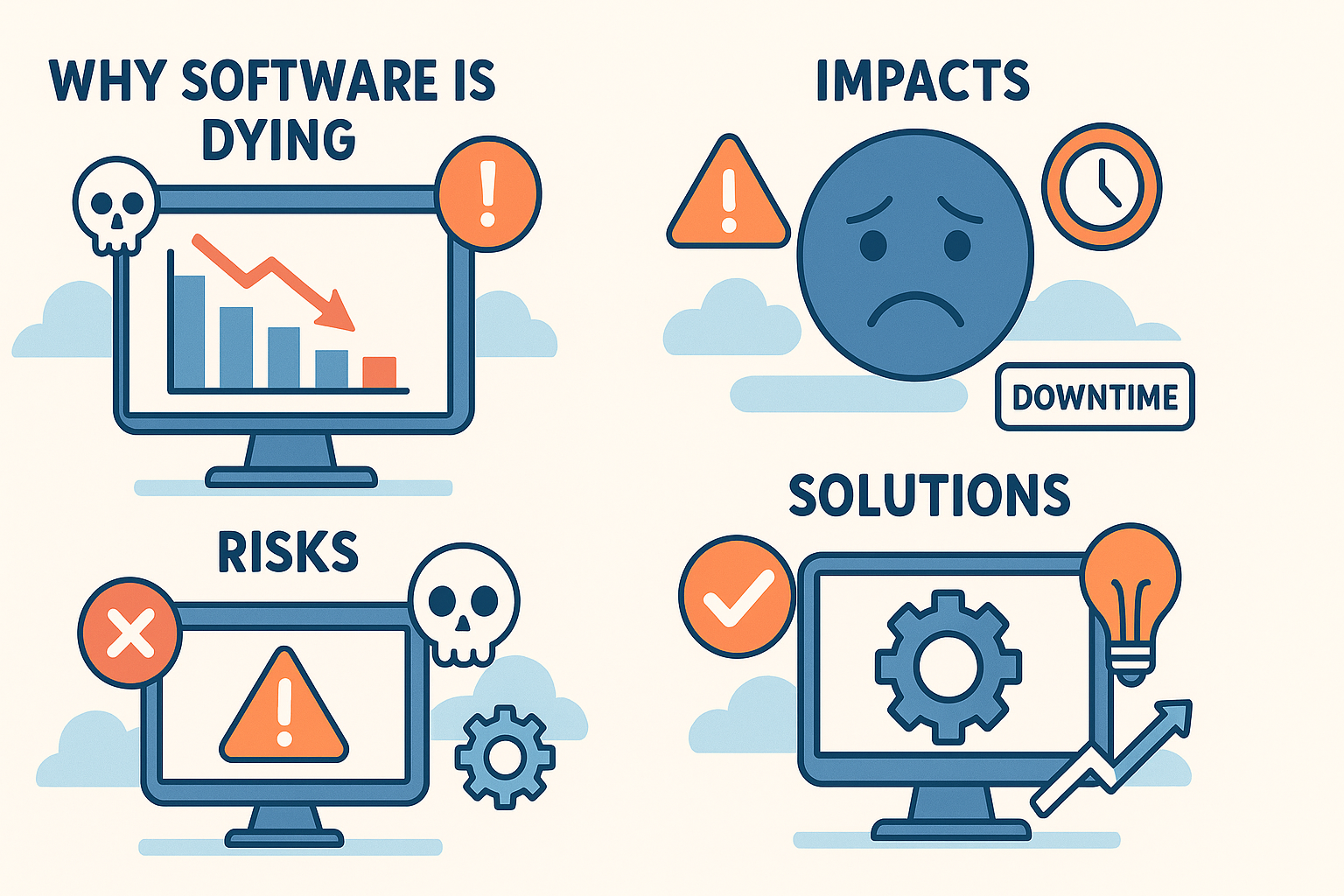Software Doxfore5 Dying: Causes, Impacts, and Possible Solutions

The phrase Software Doxfore5 Dying has been circulating widely among long-time users who once depended on this tool for their daily activities. What it reflects is the gradual decline of a once-reliable program that no longer receives quality updates, faces performance issues, and loses official support. In the fast-paced technology landscape, any software that stops improving quickly becomes outdated. This forces users to either stick with a failing tool or migrate to a better alternative before it leads to serious disruptions. Understanding the causes, warning signs, and the right steps to take is essential to ensure smooth workflows and prevent unnecessary risks.
The Life Cycle and Decline of Doxfore5
Like all digital products, software follows a life cycle. Initially, Doxfore5 may have enjoyed active development, frequent improvements, and responsive support. But as time passes, developers may lose interest, funding may dry up, or competitors may introduce more advanced solutions. This marks the stage referred to as Software Doxfore5 Dying.
At this point, the program no longer keeps up with modern systems or evolving security standards. Bugs remain unresolved, features feel outdated, and compatibility with new operating systems becomes problematic. As a result, the software begins to lose relevance, pushing users to explore better and more sustainable alternatives.
Warning Signs That Software Doxfore5 Is Dying
The decline of any program rarely happens overnight. Instead, there are clear indicators that the end is near:
-
Frequent crashes and unstable performance.
-
Noticeable lag, freezing, or slow response times.
-
Security patches stop being released, leaving users exposed.
-
Customer support becomes limited or disappears completely.
-
Incompatibility with newer operating systems or file formats.
These signs should not be ignored. Waiting too long before transitioning could result in sudden data loss or complete inaccessibility of important files.
Impact on Users and Businesses
For everyday users, the decline of Doxfore5 is frustrating, but for businesses, the situation can be devastating. Companies relying heavily on the software may face workflow interruptions, missed deadlines, reduced productivity, and even financial losses.
Another serious issue is security risk. Unsupported software becomes an easy target for cyberattacks. Businesses may also struggle with compliance requirements if they continue using outdated tools. In industries where regulations demand updated technology, the use of dying software can even result in penalties or legal consequences.
Why Software Doxfore5 Loses Support
The reasons behind Software Doxfore5 Dying can vary:
-
Developers shifting focus to new projects or technologies.
-
Rising maintenance costs that outweigh generated revenue.
-
Stronger competitors offering more advanced or affordable solutions.
-
Major technological shifts (such as cloud adoption or new programming standards).
When developers cannot sustain updates or adapt to change, software naturally declines.
Choosing a Replacement Before It’s Too Late
Once you recognize that Software Doxfore5 Dying is more than speculation, it’s wise to start exploring replacements immediately. The best options are those with:
-
Active development and frequent updates.
-
Strong customer support.
-
Proven reliability and compatibility with modern systems.
-
Clear upgrade paths for future improvements.
Making the switch early gives you time to migrate data securely and train staff without pressure.
Steps for a Smooth Transition
Switching to new software may seem overwhelming, but it becomes manageable with planning:
-
Backup Everything – Secure your files and ensure no data is lost.
-
Check Compatibility – Confirm whether the new software can read your old files.
-
Run Both Programs Temporarily – Keep Doxfore5 active until the new system is stable.
-
Train Your Team – Provide hands-on training to reduce confusion.
-
Verify Data Migration – Ensure all data transfers correctly before shutting down Doxfore5.
Preventing Similar Problems in the Future
The decline of Doxfore5 is a reminder that all software has an expiration date. To prevent similar setbacks:
-
Choose tools with active developer communities.
-
Opt for cloud-based or subscription models that ensure ongoing support.
-
Monitor update frequency and security bulletins.
-
Research the track record of providers before committing.
Being proactive is the key to avoiding another reliance on dying software.
How to Identify Reliable Alternatives
When evaluating new tools, consider:
-
The developer’s update history.
-
How quickly they address bugs and vulnerabilities.
-
User reviews from trusted sources.
-
The financial stability of the company.
-
Availability of customer support and documentation.
Reliable alternatives often have a strong community backing them, which adds an extra layer of assurance.
The Risks of Using Dying Software
Continuing to use Software Doxfore5 Dying after its safe period is risky. Hackers actively exploit outdated programs because they know vulnerabilities will never be patched. For individuals, this can lead to data theft or identity fraud. For businesses, it may cause breaches of confidential data, loss of customer trust, or financial damage.
Cost Considerations of Transitioning
One of the main reasons users hesitate to switch is cost. While investing in new software may seem expensive, the long-term risks of clinging to outdated tools are far greater. Security breaches, system failures, or downtime often cost more than the price of modern, supported alternatives.
Lessons from the Decline of Doxfore5
The fall of Doxfore5 highlights how vital it is to stay prepared in the ever-evolving tech world. Even once-reliable tools can quickly lose relevance when development slows. By staying informed, flexible, and proactive, users can protect themselves from disruption and maintain productivity.
FAQs About Software Doxfore5 Dying
Q1: What does Software Doxfore5 Dying mean?
It refers to the decline of the software due to lack of updates, poor support, and security vulnerabilities, making it less functional over time.
Q2: Is it safe to continue using Doxfore5 after support ends?
No. Unsupported software is unsafe as it becomes prone to crashes, incompatibility, and cyber threats.
Q3: How do I find a reliable alternative?
Look for tools with frequent updates, strong support, and good compatibility with your current file formats.
Q4: What is the first step in moving away from Doxfore5?
Start with a full backup of all data, then test alternatives before committing to the final transition.
Q5: Can user communities keep Doxfore5 usable?
Communities may provide patches or tips, but relying solely on them is risky for critical tasks since official updates no longer exist.
Conclusion
The reality of Software Doxfore5 Dying demonstrates the importance of adapting early. By recognizing the warning signs, planning migration carefully, and choosing a trustworthy replacement, users and businesses can avoid major setbacks. Technology evolves quickly, and the best defense is preparation. Instead of waiting for failure, act now to turn this challenge into an opportunity for improvement.
Read also:Information About Foxtpax Software: A Beginner’s Guide

